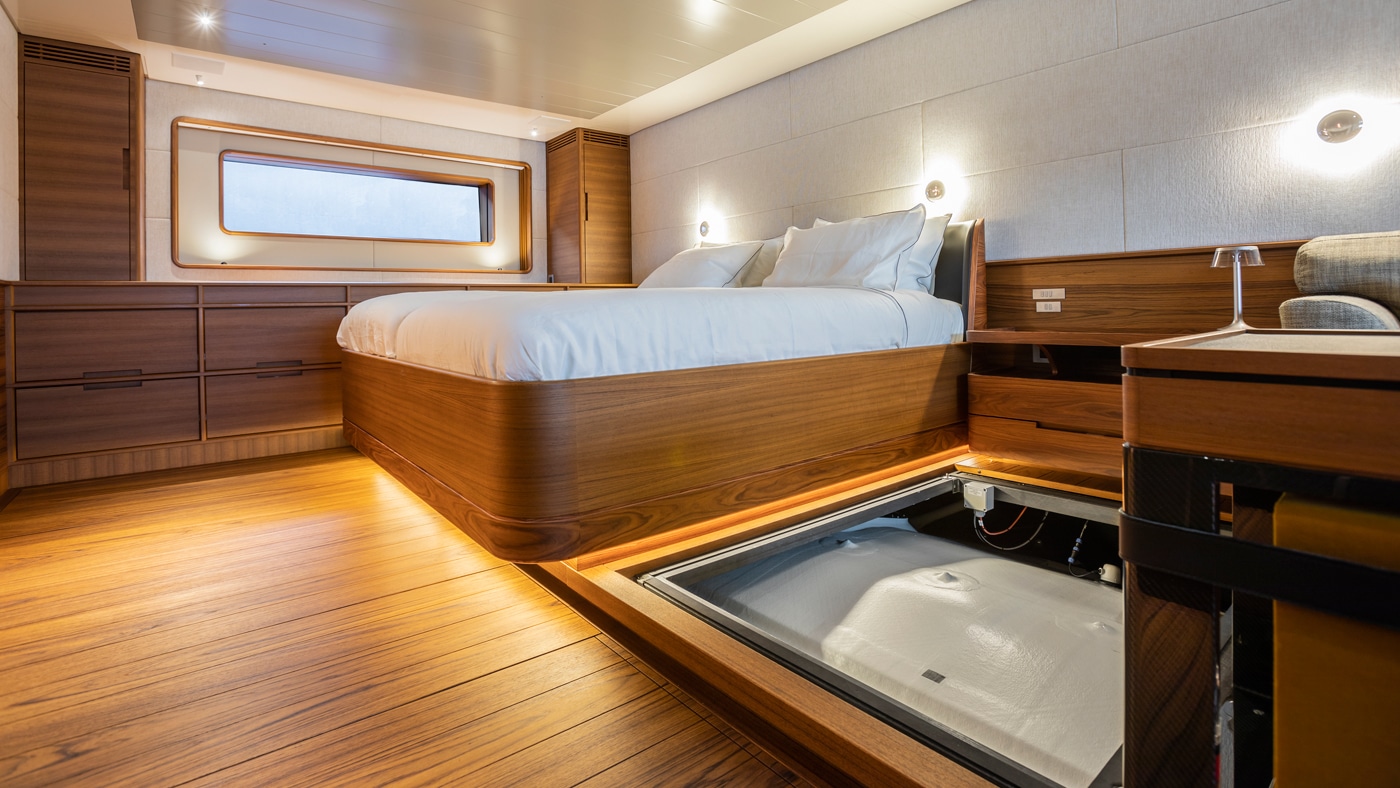DYNAMIC STABILITY SYSTEM
Aided by her DSS foil package, Baltic 142 Canova is proving herself to be faster and more comfortable than any comparable sailing yacht. Her relatively simple movable appendage, built into the bottom of the yacht, uses advanced foil profiling to create lift.
When deployed to leeward it reduces heel angle by as much as 34% and pitching by 40%, dramatically enhancing comfort for those aboard. Early feedback from the new Baltic 142 Canova reported the yacht reaching across the Bay of Biscay at 24 knots almost upright with the crew enjoying a marked reduction in motion.
- Improves comfort onboard
- Pitching reduced by as much as 40%
- Heel angle reduced by as much as 34%
- Boosts straight line sailing performance and velocity made good to windward
- Easier on the helm when foil deployed

BALTIC 142 CANOVA
Canova’s experienced owner opted for the DSS foil primarily to provide a more comfortable experience for his guests and crew as they travel the world in this extraordinary bluewater supercruiser. In winds in excess of 30 knots true during her delivery from Finland to Italy, the foil dramatically reduced the amount of yaw and pitching in an awkward sea, making the yacht easier to handle and much more comfortable for her crew.

EASY ACCESS
The 9m long foil, set in a cassette built into the bottom of the yacht, emerges just below the waterline around amidships. One of the biggest engineering challenges met by Baltic Yachts was building the mechanism into the hull beneath her luxury accommodation.
In fact, the foil runs directly beneath the owner’s cabin where its installation was made more challenging because the bunk itself can be adjusted to counteract heel angle.


HOW IT WAS BUILT
The foil runs on four sets of bearings contained in titanium housings. The outboard bearing set takes the upward load and the inner set the downward load when the foil is deployed. The foil is moved by a pulley system driven by an electric captive winch installed at deck level. To prevent water escaping from the casing, the control lines are fed through lightweight, composite tubes built into the casing, leading to a level well above the waterline. The loads imposed by the foil can be as much as 140 tonnes which not only required complex engineering of the hull but also an appreciation of the effects of greater stability on the rig and sailplan.
- Developed by Infiniti Yachts
- Naval Architecture by Farr Yacht Design
- Engineering by Baltic Yachts
- Structural engineering by Gurit
- Bearings by BAR Technologies
- Foil built by Isotop

HOW IT WORKS
DSS works by using the forward motion of the yacht combined with a retractable foil to increase stability by creating lift. The DSS foil, set to leeward of the yacht and submerged in the water, creates this lift. As the wind increases, the yacht heels and accelerates resulting in the DSS foil producing extra lift to leeward, countering the heeling force. This extra stability translates into a marked increase in performance. But the DSS has several additional benefits. The added stability it produces means a boat can be designed with a narrower hull shape. In light conditions the DSS foil is simply retracted leaving a slippery, low-drag hull shape.

THE DSS FOIL
The foil was built by French specialist fabricators ISOTOP. It weighs about 1 tonne and is designed to deflect through more than 700mm at its tips to help dampen motion. The core of the foil comprises carbon fibre spars which extend over its full length, wrapped together with layers of off-axis carbon. When deployed, the DSS foil extends 6.5m to leeward. The waterflow over the foil’s profile has the potential to create 40 tonnes of lift. 33 tonnes of extra keel weight would be needed to reduce heeling by 30 per cent without the foil
VIDEOS
SEA TRIALS DEMONSTRATE INCREASED COMFORT
The video shows both the speed and heel angle of the yacht. It is clear to see how the heel angle reduces as the speed increases. The DSS foil was also tested upwind in winds of 20-25 knots when Canova proved to be faster with much less heel. Upwind with DSS, Canova sails at 15-16 degrees of heel and without DSS at 22 degrees.
INSTALLATION
``The DSS foil is one of the most complex movable appendage we have ever fitted to a Baltic yacht`` - Roland Kasslin
MORE ABOUT DSS

FOIL-ASSISTED CRUISING
First adopted a decade ago by small racing yachts and, more recently, making the headlines as a key feature on...
MORE